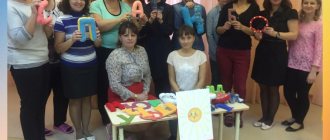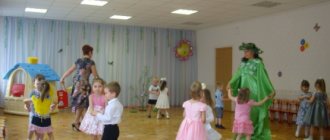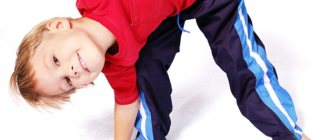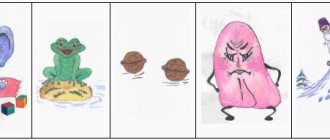Consultation for teachers of preschool educational institutions “Interaction of a speech therapist with teachers of preschool educational institutions”
Diana Kardanova
Consultation for teachers of preschool educational institutions “Interaction of a speech therapist with teachers of preschool educational institutions”
Project for creating a system of interaction between speech therapist and specialists in preschool educational institutions when working with children of senior preschool age with speech pathology
The goal is to create a system of interaction between teachers of a preschool educational institution in the process of correctional and developmental educational activities with children with speech disorders.
Tasks:
Using modern developments to improve the interaction of teachers of a preschool educational institution to create a comprehensive system of correctional and developmental activities.
Creating conditions for systematic correctional work of kindergarten specialists based on a diagnostic, preventive, correctional and developmental approach.
Formation of a mechanism that ensures a continuous increase in the speech, intellectual, mental, artistic, aesthetic and physical development of children with speech disorders.
Stages of work:
Carrying out comprehensive diagnostics by all specialists of the preschool educational institution;
Creation of a comprehensive system of correctional and developmental activities of specialists.
Development of a mechanism for interaction between preschool educational institution specialists .
Organization of the educational process in accordance with the set goals and objectives.
The first stage is a comprehensive diagnosis, which helps to identify the level of knowledge and skills of children with speech pathology and build a correctional and developmental process taking into account a person-oriented approach. All preschool specialists conduct diagnostics in their area of work. Such diagnostics are carried out in accordance with the standards of professional ethics and help to correct all deviations that the child has based on a comprehensive examination. Thus, within 3-4 weeks we get an idea of each child with speech pathology. Children are tested for phonemic awareness, vocabulary, grammar, prosodic aspects of speech, motor skills (general and fine, artistic activity (analysis of drawings)
.
Data from such diagnostics serve as the basis for teachers the most effective ways of corrective work with children with speech disorders.
The second stage - Corrective and developmental activities are an integral system. Its goal is to organize the educational activities of a preschool institution as a system that includes diagnostic, preventive and correctional and developmental aspects that ensure a high, reliable level of speech, intellectual and mental development of the child.
A speech therapist teacher conducts medical and pedagogical consultations , carries out correctional work to correct speech defects, promotes speech therapy for routine moments and activities, which helps the child’s personal growth, the formation of confident behavior, a sense of dignity, adaptation in the society of peers, and in the future – successful education at school .
The content of correctional and developmental activities of specialists is built taking into account the leading lines of speech development - phonetics, vocabulary, grammar - which ensures the integration of the speech, cognitive, mental and artistic and aesthetic development of the child.
The third stage - The system of correctional and developmental activities provides for:
conducting a system of classes (individual, subgroup, frontal)
;
creating a spatial-speech environment in kindergarten that stimulates the child’s speech development;
development of the mechanism of the model of interaction between teachers ( speech therapist , educators, educational psychologist , music director, physical education instructor, art studio director);
the use of effective methods and techniques that activate the speech activity of speech-language pathologist children.
The main direction is the creation of a unified speech space that stimulates the child’s speech development (equipment of speech zones: mirrors for articulatory and facial gymnastics, visually illustrated material on lexical topics, main phonetic groups, plot pictures for working on phrases, toys for improving speech breathing, various aids for the development of fine motor skills, visual memory and phonemic hearing).
Organization of interaction between a speech therapist and teacher :
The leading role of the speech therapist in the pedagogical process is explained by the fact that the speech therapist, as a specialist, knows better the speech characteristics and capabilities of children with various speech pathologies, the degree of lag in speech development compared to the age norm, the dynamics of correctional work, as well as the principles, methods and techniques of developing correct speech skills in children with speech pathology.
At the beginning of the school year, the speech therapist introduces teachers to the results of the examination of children and draws their attention to the features of speech development.
Educators should hear children’s speech defects not only in phonetic, but also in its grammatical form and know that children’s mistakes are not an accident, but a symptom of their speech problems.
At the same time, the speech of educators must be extremely literate and phonetically correct, since it serves as a model for children with speech pathology.
Educators must promote the development of all intact analyzers of children, thereby strengthening and expanding the compensatory capabilities of children, carrying out correctional work in various directions.
The speech therapist develops correct speech skills, and the teacher reinforces these skills.
For fruitful work on overcoming speech defects in children, the following can be used when working with educators:
maintaining a notebook of interaction between specialists with recommendations and tasks;
carrying out work prior to speech therapy classes to accumulate, expand, and activate the vocabulary, providing the necessary cognitive and motivational basis for the formation of speech skills.
speech therapy of routine moments and activities;
conducting systematic exercises to develop breathing, articulation, fine and gross motor skills;
conducting classes in mathematics, cognitive development, artistic and creative activities, integrating speech therapy goals.
creating conditions in the group that promote the activation of children’s speech;
systematic monitoring of children’s speech not only during classes, but also during restricted periods;
explanation (if necessary)
assignments
from a speech therapist to parents to consolidate the material covered during home activities, which include replenishment, clarification, activation of the dictionary, consolidation of correct sound pronunciation, development of fine and articulatory motor skills.
The speech therapist monitors and provides the teacher with the necessary assistance.
It is recommended to allocate a place in the group for speech therapy classes, the so-called speech therapy corner, in which there should be board and printed games for the formation of the correct air flow, for the development of non-speech processes, etc.
Collaboration between a speech therapist and a psychologist :
The tasks of the correctional work of a speech therapist and psychologist are closely interrelated and are solved within the framework of a holistic approach to the formation of a child’s mental activity. Training is aimed at overall development, and not at training individual processes.
The main direction of the correctional and developmental work of a psychologist is the development of the emotional-volitional sphere, promoting the full mental and personal growth of each child.
Together with a psychologist, at the beginning of the school year, an examination and diagnosis are carried out, compensatory possibilities, difficulties in personal development and intellectual and cognitive activity are identified.
It is necessary to combine psychocorrectional work with pedagogical correction . For this purpose, the following techniques are used:
Fairytale therapy techniques using works of domestic and foreign authors;
Art therapy and music therapy techniques;
Techniques of body-oriented psychotherapy.
Psychocorrectional games.
Psychocorrectional games can be conducted by a psychologist, educators, and sometimes jointly. Games are selected according to the characteristics of children. Timid, slow children are appointed as drivers, and the main roles are chosen for them. For hyperactive children, calmer games are selected.
Fairytale therapy involves a psychocorrective effect on children through reading specially selected literature in order to normalize and optimize their mental state.
When reading works, take into account :
The degree of accessibility of the presentation, which depends on the understanding of the text and the level of speech development of children;
Similarities between the situations in the book and the situations in which the child finds himself;
Lexical topic.
Art therapy and music therapy techniques.
Psychocorrectional work using art therapy has a great therapeutic and correctional effect when working with children with problems in both intellectual and emotional-personal development. To enhance positive internal processes in children, special musical accompaniment can be used to stimulate their speech.
Techniques of body-oriented psychotherapy
In correctional work with children, the emphasis is on analyzing their feelings, emotional state, and behavior at the current moment in time in a given situation, learning to make decisions independently and being responsible for them. Children acquire such skills by mastering exercises in the following areas:
Practicing communication skills, developing cooperation skills;
Release from muscle tension;
Development of attention, sensory perception.
The main goals of exercises aimed at developing body plasticity in children with speech disorders:
Increasing the range of emotional manifestations;
Improving psychomotor skills, developing the ability to freely control your body.
Thus, psychocorrectional work, based on a combination of well-known psychotherapeutic techniques, significantly increases the effectiveness of correctional and pedagogical work with children with speech disorders.
Collaboration between a speech therapist and the head of an art studio
Development of artistic and creative abilities.
The ability to act according to verbal instructions is developed.
Development of fine motor skills.
Inventing fairy tales from drawings.
Inclusion of proverbs, sayings, tongue twisters and short poems into the lesson.
Collaboration between a speech therapist and a music director
The music director selects and introduces music therapy works into the child’s daily life, conducts planned music classes that use elements of logorhythmics, and conducts logorhythmic classes together with a speech therapist.
Logorhythmic classes improve general and fine motor skills (coordination of movements, manual praxis, articulatory muscles, expressiveness of facial expressions, plasticity of movements, breathing, voice, prosodic side of speech (tempo, timbre, expressiveness, voice strength)
.
In music classes - mastering musical, motor and speech materials. In the process of joint work the following can be used:
musical works of various genres;
logorhythmic exercises;
exercises to develop coordination between movement and words;
games and exercises to develop breathing;
games and exercises to develop the prosodic side of speech (tempo, voice strength, expressiveness)
.
exercises to develop facial movements.
The relationship between the work of a speech therapist and a physical education instructor.
An examination of children with speech pathology often shows that they have insufficient coordination of complex movements, motor clumsiness, inaccuracy, a lag behind the given pace of movements, a violation of the smoothness and amplitude of the movements performed.
A joint discussion of the diagnostic results will allow us to outline a plan for correctional and educational work in physical education classes.
Tasks:
establishing proper breathing (separation of nasal and oral breathing, practicing lower diaphragmatic breathing);
development of motor skills: general (coordination of movements)
and small
(fingers)
;
expansion and enrichment of vocabulary.
Interaction with family
Teachers work on interaction between kindergarten and family in the process of personality-oriented communication. The basis of communication is the individual characteristics of the speech development of each child, obtained as a result of an examination at the beginning of the school year.
The goal of interaction is to unite the efforts of adults for the successful speech development of each child with speech pathology; to create in parents a desire to help their child and communicate with him; be able to respond correctly to problems (help overcome them)
and achievements
(rejoice at success)
.
Activate and enrich the educational skills of parents, maintain their confidence in their own pedagogical capabilities .
Continuous communication with parents is carried out through collective, individual, visual forms of work and includes:
questionnaires, polls,
parent meetings,
individual and group meetings, consultations ,
class views,
open days,
homework for children, which is done together with parents,
themed evenings “Lessons for Parents”
,
thematic exhibitions.
Group parent meetings are held 3 times a year. They help unite parents and actively participate in the process of raising children. At the first group parent meeting, parents are explained that they are responsible for creating the child’s motivation to study at home, conducting classes with the child in various forms outside the kindergarten, and taking additional measures in the presence of violations associated with the main defect. It is extremely important to explain to parents the need for intensive, daily work with their child on the instructions of teachers . Only in this case are the best results possible.
Consultations and group meetings are structured so that they are not formal, but, if possible, involve parents in solving problems and develop the spirit of fruitful cooperation. Consultations contain only the specific material parents need.
Sample topics for consultation :
Articulation gymnastics;
Development of fine motor skills;
Doing homework;
Development of memory, attention and thinking (together with a psychologist)
;
Speech games at home;
Automation of sound at home;
How to teach a child to read ;
Training in practical work techniques.
Individual work allows you to establish closer contact with parents.
Questioning involves a fixed order, content and form of questions, and a clear indication of answer methods. Using a survey, you can find out the composition of the family, the characteristics of family upbringing, the positive experiences of parents, their difficulties, and mistakes. By answering the questionnaire, parents begin to think about the problems of upbringing, about the peculiarities of raising a child. It is considered important to identify the needs of parents in pedagogical knowledge . For example, “on what issues in your child’s education would you like to receive a speech therapist’s recommendation? ” Parents report what problems concern them, and these issues are revealed at meetings, group and individual meetings. The peculiarities of family education, the parents' needs for knowledge, can also be identified through conversation, the most important feature of which is bilateral activity. At the beginning of the year, after examining the children. The speech therapist informs parents about the results. The child’s relatives receive advice and recommendations. The conversation is conducted in a tactful manner: its task is to help the family in the child’s speech education. How the first meetings between the speech therapist and parents will determine whether their cooperation will improve in the future.
Individual workshops on teaching parents joint forms of activities with children are correctional in nature (articulation gymnastics, formation of sound pronunciation, development of phonemic hearing, formation of the syllabic structure of words, etc.). Those parents who have difficulties working with children at home due to a lack of skills in organizing the child’s behavior or low pedagogical literacy are invited to watch individual speech therapist . Adults learn practical techniques for working with a child, which are very important for achieving results in the correctional process.
The main form of interaction with parents for a speech therapist is a homework notebook. Depending on the severity of the speech disorder, tasks in the notebook are given not only on sound pronunciation, but also on the formation of vocabulary, grammatical skills and abilities for the development of attention and memory, etc.
The visual form of the work is also very important. The visibility of the campaign can be ensured by the use of a variety of accompanying illustrations, demonstrations of practical work, and exhibition material - it stimulates the activity of parents.
It would be advisable to carry out individual work with parents not only orally, but also in writing (a diary of working with parents, a feedback notebook, etc., where each specialist could write down their recommendations). Since addressing only orally takes a lot of time and parents are not always able to retain in memory all the information that they consistently receive from teachers . And, therefore, in order for parents to be able to comprehend the recommendations received and follow them, they must first be convinced of this, offer a certain algorithm of actions and arm them with a reminder that will allow them to carry out these actions consistently and accurately.
Interaction between kindergarten and family is a necessary condition for the full speech development of preschool children.
This interaction can contribute to effective, qualitative changes in children’s speech development, professional growth of teachers , and increased competence and pedagogical literacy of parents.






